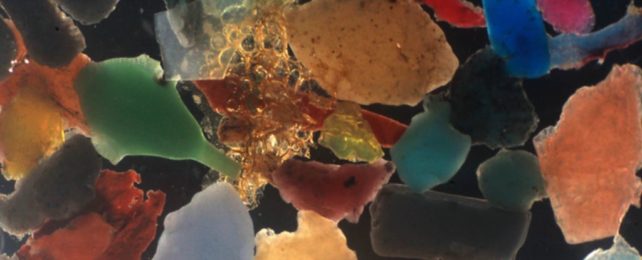Plastic pollution is out of control. Each year, more than 8 million tonnes of synthetic polymers enter the ocean, and while some sinks to the floor, returns to the shore, or collects in the middle of nowhere, a significant portion isn't so easily accounted for.
All that missing plastic is a mystery, but some researchers suspect hungry microbes are partly responsible.
Experiments in the lab have now shown that a species of marine bacterium, known as Rhodococcus ruber, can slowly break down and digest plastic made from polyethylene (PE).
Used largely in packaging, PE is the most commonly produced plastic in the world, and while it's not clear if R. ruber munches on this waste in the wild, the new research confirms it is at least capable of doing so.
Previous studies have found strains of R. ruber floating in dense cellular films on marine plastic. What's more, initial research in 2006 suggested the plastic underneath R. ruber was breaking down at a faster rate than normal.
The new study confirms that to be the case.
"This is the first time we have proven in this way that bacteria actually digest plastic into CO2 and other molecules," says microbial ecologist Maaike Goudriaan from the Royal Netherlands Institute for Sea Research (NIOZ).
To emulate the natural ways that plastic disintegrates on the ocean surface, Goudriaan and her colleagues exposed their plastic samples to UV light and placed them in artificial seawater.
"The treatment with UV light was necessary because we already know that sunlight partially breaks down plastic into bite-sized chunks for bacteria," explains Goudrian.
Next, the team introduced a strain of R. ruber to the scene.
By measuring levels of an isotope of carbon released from disintegrating plastic called carbon-13, the authors estimated the polymers in their experiments broke down at a rate of about 1.2 percent a year.
The team can't be sure how much the UV lamp decayed the plastic compared to the activity of the microbes, but the bacteria were clearly playing a role. Bacterial samples after the experiment showed fatty acid membranes that were enriched with carbon-13.
The rate of plastic decay identified in the current study is far too slow to completely solve the problem of plastic pollution in our oceans, but it does indicate where some of our planet's missing plastic might have gone.
"Our data show that sunlight could thus have degraded a substantial amount of all the floating plastic that has been littered into the oceans since the 1950s," says microbiologist Annalisa Delre.
Microbes could have then come in and digested some of the Sun's leftovers.
Since 2013, researchers have warned that microbes are likely thriving on plastic patches in the ocean, forming a synthetic ecosystem that has come to be known as a 'plastisphere'.
There's even evidence to suggest that some of these microbial communities are adapting to eating different types of plastic.
Previous studies have identified specific bacteria and fungi, on land and in the sea, that appear to eat plastic. But while that knowledge could help us better recycle our waste before it ends up in the wild, its other uses are controversial.
Some scientists have proposed we unleash plastic-munching equivalents on pollution hotspots, like the Great Pacific Garbage Patch.
Others are not so sure that's a good idea. Engineered enzymes and bacteria that break down plastic might sound like a great way to make our waste disappear, but some experts are worried about unintended side effects to natural ecosystems and food webs.
After all, breaking down plastic isn't necessarily a good thing. Microplastics are a lot harder to clean up than larger pieces, and these tiny remnants could infiltrate food webs. Filter feeders, for instance, might mistakenly grab tiny pieces of plastic before microbes do.
In a study in 2020, every single seafood sample tested at a market in Australia contained microplastics.
What that is doing to human or animal health is completely unknown.
"Much better than cleaning up, is prevention," argues Goudriaan.
"And only we humans can do that."
The study was published in Marine Pollution Bulletin.
